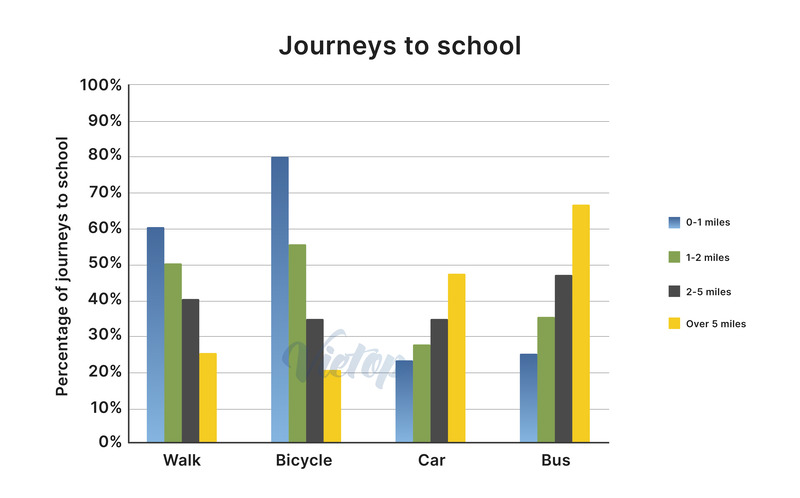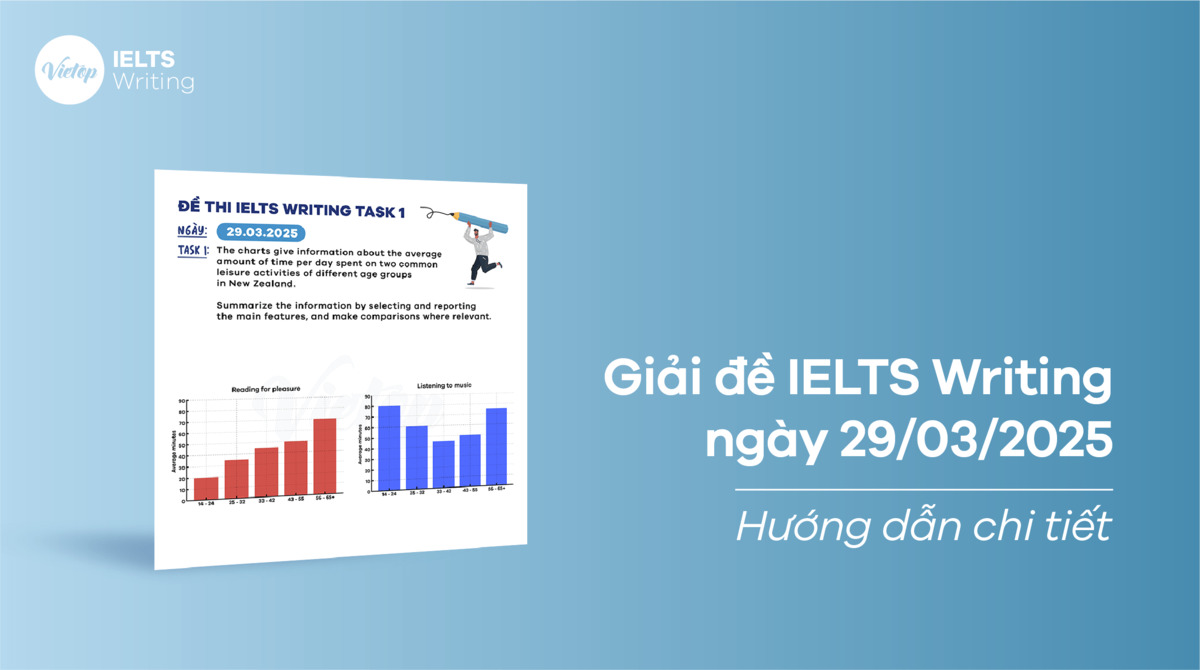Nếu ở đề thi IELTS Writing ngày 06/04/2024 với sự xuất hiện của dạng đề bar chart ở phần IELTS Writing task 1. Thì đề thi IELTS Writing ngày 13/04/2024 các bạn vẫn gặp lại dạng đề bar chart này và có sự thay đổi ở dạng đề IELTS Writing task 2. Cụ thể:
- Yêu cầu phần thi IELTS Writing task 1 dạng đề bar chart với chủ đề “The journeys to school by children aged 11 to 16 in the UK in a year.”
- Yêu cầu của phần thi IELTS Writing task 2 với dạng thảo luận quan điểm “Some people say that when deciding how taxes should be spent, the government should prioritize health care. Others think that there are more important priorities for tax-payers’ money. Discuss both views and give your opinion.”
Vậy ý tưởng triển khai cho bài thi này như thế nào? Cùng thầy phân tích và giải đề IELTS Writing ngày 13/04/2024 chi tiết qua bài viết sau.
Cùng học ngay thôi nào!
IELTS Writing task 1
The chart below gives information about the journeys to school by children aged 11 to 16 in the UK in a year. Summarise the information by selecting and reporting the main features, and make comparisons where relevant.
(Biểu đồ dưới đây cung cấp thông tin về hành trình đến trường của trẻ em từ 11 đến 16 tuổi ở Anh trong một năm. Tóm tắt thông tin bằng cách chọn và báo cáo các tính năng chính và so sánh nếu có liên quan.)

Bước 1: Lập dàn ý
Đoạn tổng quan:
Nhìn chung, đi bộ và xe đạp là các phương tiện ưa thích cho các chuyến đi ngắn, trong khi có nhiều em học sinh đi học bằng xe hơi và xe buýt cho các chuyến đi xa hơn.
| Thân bài 1 | Thân bài 2 |
| – Đa số người đi xe đạp di chuyển từ 0-1 dặm, với 80% các chuyến đi loại này được thực hiện bởi trẻ em trong nhóm tuổi được kiểm tra, trong khi tỷ lệ này của việc đi bộ đến trường với cùng khoảng cách là 60%. Trong khi đó, con số cho các chuyến đi bằng xe hơi và xe buýt thấp hơn đáng kể và thú vị là giống nhau, với con số khoảng 25% cho mỗi loại phương tiện. – Điều này hoàn toàn trái ngược với chuyến đi hơn 5 dặm, với tỷ lệ lớn nhất thuộc về hành khách đi xe buýt (gần 70%). Gần dưới 50% trẻ em được đưa đến trường bằng chuyến đi xe hơi có khoảng cách hơn 5 dặm, so với 25% và khoảng 20% lần lượt cho đi bộ và xe đạp. | Đối với các chuyến đi từ 1-2 dặm, tỷ lệ người đi xe đạp hơi nhiều hơn so với người đi bộ, với 55% các chuyến đi được thực hiện bởi người đi xe đạp so với 50% cho người đi bộ. Dữ liệu tương ứng cho xe buýt và xe hơi thấp hơn (khoảng 35% so với gần 28%). Đối với các chuyến đi từ 2-5 dặm, xe buýt là loại phương tiện chiếm ưu thế trong danh mục này, chiếm 48%, trong khi tỷ lệ của các phương tiện còn lại dao động từ 35% đến 40%. |
Xem thêm: Các dạng biểu đồ trong IELTS Writing task 1 và chiến lược làm bài hiệu quả
Bước 2: Hoàn thành bài luận
The bar chart illustrates four means of traveling to school, along with their respective distances among children in the 11-16 age group in the UK in one year.
Overall, walking and bicycles were the preferred modes of transportation for short-distance journeys, whereas there were far more children commuting to school by means of cars and buses for longer trips.
The majority of bicycle riders rode from 0-1 miles, with 80% of this kind of journey being made by children of the examined age group, whereas a slightly lower percentage of children walked to school with the same respective distances, at 60%. Meanwhile, the figures for car and bus journeys were noticeably lower and interestingly the same, with a figure of around 25% for each type of transport. This is in stark contrast to the over 5-mile-journey, which recorded the greatest proportion among bus passengers (a little under 70%). Slightly below 50% of children were taken to school by car journey with a distance of more than 5 miles, in comparison to 25% and around 20% for walking and bicycle respectively.
As for 1-2-mile journeys, the proportion of bicycle riders slightly outnumbered that of pedestrians, with 55% of trips being made by the former compared to 50% for the latter. Bus and car usage, however, accounted for much lower percentages (35% as opposed to nearly 28%). With regard to 2-5 miles, bus was the dominant type of vehicle in this category, making up 48%, whereas the percentages of the remaining means ranged from 35% to 40%.
Xem thêm:
- Cách nói tăng/ giảm trong IELTS Writing Task 1 hay nhất
- Những cấu trúc ăn điểm trong IELTS Writing Task 1 mà bạn không nên bỏ qua
- Hướng dẫn cách viết dạng Maps IELTS Writing Task 1
IELTS Writing task 2
Some people say that when deciding how taxes should be spent, the government should prioritize health care. Others think that there are more important priorities for tax-payers’ money. Discuss both views and give your opinion.
(Một số người cho rằng khi quyết định cách chi tiêu thuế, chính phủ nên ưu tiên chăm sóc sức khỏe. Những người khác cho rằng có những ưu tiên quan trọng hơn đối với tiền của người nộp thuế. Thảo luận cả hai quan điểm và đưa ra ý kiến của bạn.)
Bước 1: Phân tích đề
- Từ khoá: Taxes, spent, healthcare, more important priorities
- Câu hỏi: Vietop sẽ đi theo quan điểm rằng sức khỏe và những vấn đề khác đều nên được ưu tiên nhận được thuế từ chính phủ.
Bước 2: Lập kế hoạch cho bài luận
| Thân bài 1 | Thân bài 2 |
| A. Argument: Health care is a fundamental human right and cornerstone of social welfare B. Supporting ideas: – Investing in health care infrastructure, medical research, and public health initiatives yields significant benefits. – Accessible and affordable health care services contribute to improved public health outcomes, reduced mortality rates, and enhanced quality of life. – A robust health care system can bolster economic productivity. | A. Argument: Competing demands merit attention and financial resources B. Supporting ideas: – Addressing pressing issues such as education, infrastructure, national security, and economic development is essential. – Neglecting other priorities could hinder progress in critical areas and undermine societal well-being. – Increased health care spending may not necessarily lead to improved health outcomes due to systemic challenges. |
| Conclusion: – Advocates for a balanced approach to tax allocation considering various priorities. – By striking a balance, governments can effectively address diverse societal needs and ensure prosperity and welfare of all citizens. | |
Bước 3: Hoàn thành bài luận
Some argue that health care should be the primary area when determining how taxes are allocated, while others contend that there are more pressing priorities deserving of taxpayers’ money. There is indeed a strong case to be made for both sides of the debate, which will be discussed now.
Proponents of prioritizing health care in tax allocation argue that it is a fundamental human right and a cornerstone of social welfare. They contend that investing in health care infrastructure, medical research, and public health initiatives yields significant benefits for individuals and society as a whole. Accessible and affordable health care services contribute to improved public health outcomes, reduced mortality rates, and enhanced quality of life. Moreover, a robust health care system can bolster economic productivity by reducing absenteeism, preventing costly medical emergencies, and promoting overall well-being. Therefore, proponents advocate for allocating a significant portion of tax revenue to bolstering health care services and ensuring equitable access for all citizens.
On the other hand, opponents of prioritizing health care spending argue that there are competing demands that warrant attention and financial resources. They contend that addressing pressing issues such as education, infrastructure, national security, and economic development is essential for the long-term prosperity and stability of society. Neglecting these priorities in favor of disproportionately allocating funds to health care could hinder progress in other critical areas and undermine overall societal well-being. Furthermore, they argue that simply increasing health care spending does not necessarily equate to improved health outcomes, as inefficiencies, mismanagement, and systemic challenges within the health care system may persist despite increased funding. Therefore, opponents advocate for a more balanced approach to tax allocation that considers a range of societal needs and priorities.
In conclusion, while health care is undeniably vital, I believe that a balanced approach to tax allocation that considers various priorities is essential for promoting comprehensive societal development and well-being. By striking a balance between competing demands, governments can effectively allocate resources to address the diverse needs of society and ensure the prosperity and welfare of all citizens.
Chủ đề thuế – một vấn đề thường được đưa vào đề thi Writing task 2? Đây là một chủ đề sẽ gây nhiều khó khăn cho các bạn học sinh, sinh viên. Vậy nếu bạn chưa có nhiều kiến thức về chủ đề thuế hoặc những chủ đề khó khác thì làm sao giải quyết tốt với các dạng bài thi này? Trong khoá học IELTS 6.0 tại Vietop, các bạn sẽ được thầy cô 8.0+ IELTS hướng dẫn chi tiết về cách làm tưng dạng bài cũng như cách xử lý các chủ đề khó, cách sử dụng vốn từ phù hợp cho từng ngữ cảnh, … giúp bạn tự tin chinh phục band điểm mục tiêu.
Bước 4: Từ vựng
| Vocabulary | Meaning in Vietnamese |
| Tax allocation | Phân bổ thuế |
| Cornerstone | Nền tảng, cột mốc chính |
| Robust | Mạnh mẽ, cứng cáp |
| Equitable access | Truy cập công bằng |
| Disproportionately | Một cách không cân đối |
| Societal well-being | Phúc lợi xã hội |
| Welfare | Sự phúc lợi, hạnh phúc |
- The government’s ___________ of funds determines how resources are allocated to different sectors.
- Education is considered a ___________ of a nation’s development.
- A ___________ healthcare system ensures that all citizens have equal access to medical services.
- Some argue that healthcare spending is allocated ___________ compared to other societal needs.
- Improving public health contributes to overall ___________.
- Social programs aim to enhance the ___________ of citizens.
Answers:
- Tax allocation
- Cornerstone
- Equitable access
- Disproportionately
- Societal well-being
- Welfare
Xem thêm:
- [ACE THE TEST] Giải đề IELTS Writing ngày 23/03/2024
- [ACE THE TEST] Giải đề IELTS Writing ngày 16/03/2024
- [ACE THE TEST] Giải đề IELTS Writing ngày 09/03/2024
Như vậy, các bạn đã vừa cùng thầy phân tích và hoàn thành bài mẫu chi tiết giải đề IELTS Writing ngày 13/04/2024. Bạn đã nắm vững cách phân tích và lên ý tưởng cho đề thi IELTS Writing?
Để các bạn nắm vững cách làm bài, thầy lưu ý đến các bạn một số thông tin sau:
- Xác định dạng đề và hướng làm bài.
- Take note các thông tin quan trọng của đề bài.
- Lập dàn ý dựa trên những phân tích trước.
Bên cạnh đó, các bạn nên thường xuyên theo dõi bộ tổng hợp đề thi IELTS Writing 2024 mới nhất của Vietop English để cập nhật những đề thi IELTS sớm nhất.


![[ACE THE TEST] Giải đề IELTS Writing ngày 07/04/2025](https://vietop.edu.vn/wp-content/uploads/2025/04/giai-de-ielts-writing-ngay-07-04-2025.png)

![[ACE THE TEST] Giải đề IELTS Writing ngày 15/03/2025](https://vietop.edu.vn/wp-content/uploads/2025/03/giai-de-ielts-writing-ngay-15-03-2025.jpg)
![[ACE THE TEST] Giải đề IELTS Writing ngày 22/03/2025](https://vietop.edu.vn/wp-content/uploads/2025/03/giai-de-ielts-writing-ngay-22-03-2025.jpg)
![[ACE THE TEST] Giải đề IELTS Writing ngày 08/03/2025](https://vietop.edu.vn/wp-content/uploads/2025/03/giai-de-ielts-writing-ngay-08-03-2025.jpg)
![[ACE THE TEST] Giải đề IELTS Writing ngày 06/03/2025](https://vietop.edu.vn/wp-content/uploads/2025/03/giai-de-ielts-writing-ngay-06-03-2025.jpg)
![[ACE THE TEST] Giải đề IELTS Writing ngày 22/02/2025](https://vietop.edu.vn/wp-content/uploads/2025/02/giai-de-ielts-writing-ngay-22-02-2025.jpg)
